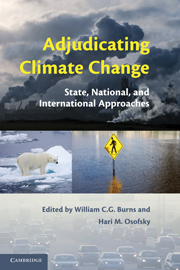Book contents
- Frontmatter
- Contents
- Foreword
- Acknowledgments
- Adjudicating Climate Change
- 1 Overview: The Exigencies That Drive Potential Causes of Action for Climate Change
- PART I SUBNATIONAL CASE STUDIES
- PART II NATIONAL CASE STUDIES
- PART III SUPRANATIONAL CASE STUDIES
- 11 The World Heritage Convention and Climate Change: The Case for a Climate-Change Mitigation Strategy beyond the Kyoto Protocol
- 12 The Inuit Petition as a Bridge? Beyond Dialectics of Climate Change and Indigenous Peoples' Rights
- 13 Bringing Climate Change Claims to the Accountability Mechanisms of International Financial Institutions
- 14 Potential Causes of Action for Climate Change Impacts under the United Nations Fish Stocks Agreement
- 15 Climate Change Litigation: Opening the Door to the International Court of Justice
- 16 The Implications of Climate Change Litigation: Litigation for International Environmental Law-Making
- 17 Conclusion: Adjudicating Climate Change across Scales
- Index
- References
14 - Potential Causes of Action for Climate Change Impacts under the United Nations Fish Stocks Agreement
Published online by Cambridge University Press: 25 August 2009
- Frontmatter
- Contents
- Foreword
- Acknowledgments
- Adjudicating Climate Change
- 1 Overview: The Exigencies That Drive Potential Causes of Action for Climate Change
- PART I SUBNATIONAL CASE STUDIES
- PART II NATIONAL CASE STUDIES
- PART III SUPRANATIONAL CASE STUDIES
- 11 The World Heritage Convention and Climate Change: The Case for a Climate-Change Mitigation Strategy beyond the Kyoto Protocol
- 12 The Inuit Petition as a Bridge? Beyond Dialectics of Climate Change and Indigenous Peoples' Rights
- 13 Bringing Climate Change Claims to the Accountability Mechanisms of International Financial Institutions
- 14 Potential Causes of Action for Climate Change Impacts under the United Nations Fish Stocks Agreement
- 15 Climate Change Litigation: Opening the Door to the International Court of Justice
- 16 The Implications of Climate Change Litigation: Litigation for International Environmental Law-Making
- 17 Conclusion: Adjudicating Climate Change across Scales
- Index
- References
Summary
The seas – all the seas – cry for regulation as a veritable res communis omnium.
INTRODUCTION
This chapter examines another potential international forum in which the threat of climate change might be addressed, the Agreement for the Implementation of the Provisions of the U.N. Convention on the Law of the Sea 10 Dec. 1982 Relating to the Conservation and Management of Straddling Fish Stocks and High Migratory Fish Stocks (“UNFSA”). Actions under UNFSA could be salutary for several reasons. First, as outlined hereafter, the commercial fisheries sector may be profoundly and adversely affected by climate change. This includes many fish stocks regulated under UNFSA: highly migratory species, which have wide geographic distribution and undertake significant migrations, and straddling stocks, which occur both within and beyond Exclusive Economic Zones (EEZs). Overall, “[m]igratory and straddling species account for roughly 20% of the total marine catch and include some of the most economically valuable fish populations.”
Second, the United States, one of the world's largest emitter of greenhouse gases and a State with an abject record in addressing climate change, was one of the first nations to ratify UNFSA and has played an active leadership role in its implementation. UNFSA thus presents an excellent forum in which to engage the United States, as well as other major greenhouse gas emitters, including the European Union and China, on climate issues. Finally, unlike the other international fora where climate change actions have been pursued to date, UNFSA provides a dispute resolution mechanism with teeth.
- Type
- Chapter
- Information
- Adjudicating Climate ChangeState, National, and International Approaches, pp. 314 - 333Publisher: Cambridge University PressPrint publication year: 2009
References
- 2
- Cited by



